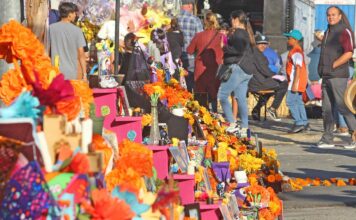Don Christopher, the founder of the country’s biggest garlic producer, Christopher Ranch, started 60 years ago in Gilroy with 12 acres of the spicy bulb, sandwiched between his main crops, lima beans and sugar beets. The man who was then known as the king of garlic, Joe Gubser, asked Christopher to plant some bulbs for him. He sold the garlic to Gubser for 9 cents a pound.
Christopher, a descendent of Danish farmers, was 22 and part of a family farming tradition that began in San Jose with prunes. He bought a plot of 130 acres in Gilroy with a $75,000 loan from his father and began what grew into a company that employs 400-1,000 people a year.
Today, his Christopher Ranch, located off Highway 25, plants 4,000 acres and sells 60 million pounds of garlic a year. In stores, it sells from $2.00-$4.00 a pound.
Christopher Ranch is a family business, with his sons managing it and his grandkids working there. Don, 82, shared some insights into the crop and his life.
Gilroy may be the ‘Garlic Capital,’ but not much is grown here.
Only 200-300 acres of garlic are grown in Gilroy, but almost all California garlic is processed here. The rest comes from all over the state, including 400 acres in San Benito County. Growing garlic is a two-year process, starting with seeds that are grown in cold climates in Oregon and northern Nevada and shipped down to California, where they are planted and harvested nine months later.
Garlic was not a popular crop when Christopher started. Most Americans used garlic powder as a seasoning, rather than using actual cloves. But each year, since 1957, he raised his sales by 10 percent, at first through face to face marketing, and then aided by TV shows and the garlic festival.
The Garlic Festival was kind of a fluke
The festival was the brainchild of Gavilan College President Rudy Melone, who badgered Christopher and anyone who would listen in the mid-1970s, to start a festival for Gilroy’s signature crop. He was largely ignored, but kept pitching the idea at the Gilroy Rotary Club. Finally, he convinced Christopher to hold a garlic dinner at his ranch for Rotary members.
Christopher had started an association for garlic growers—the Fresh Garlic Association—and hired a PR person to help out named Carol Saunders, who also represented lettuce growers. She invited Los Angeles Times food critic Betsy Balsley, who raved about the garlic-laden food cooked by Val Filice and convinced Christopher to take the next step and create a festival.
After five months of work by 15 organizers, it came to life in 1979 at a piece of property at Castro Valley Road and Highway 101. Because no one seemed interested, they only printed a few hundred tickets, but drew 5,000 people. They had to reuse the tickets, reselling the ones they collected.
When they realized they had a hit, they wanted to do it the following year in the same field, a field that actually had garlic growing on it. But the Santa Clara County officials cracked down, saying they needed flush toilets and running water. So they pitched the city, which offered Christmas Hill Park, where the festival has been since, attracting 100,000 people for three days.
As grows the festival, so grows Christopher
Before the Garlic Festival, Americans ate an average of one pound of garlic a year. After it, they ate three pounds a year, a figure that has held steady, says Christopher’s marketing director Patsy Ross.
“Coincidence? I don’t think so,” she says.
Two other things propelled the popularity of the bulb known as the “Stinking Rose.” One was developing and selling peeled garlic. The company sold garlic chopped up in jars of oil or pesto, but not on its own.
“One day I was watching the cloves go by, all peeled, and I said ‘I think we can sell this,’” recalls Christopher. “That was probably the best thing I ever thought of. So I took 20 boxes and sent them up to (the produce market in) Oakland to find out if there was anybody who wanted it. And of course, it sold out in an hour.”
He drove his own truck up to other markets in San Francisco and sold it out there. Before long, he was sending it all over the country.
“When we sold our first million pounds of peeled garlic, we brought out champagne,” says Ross. “We were so ecstatic. Now, if we sell less than a million pounds a month, it’s a bad month.”
For the first Garlic Festival, the garlic was peeled by hand. Later, Christopher had a machine that used sandpaper to remove the husk. Finally, someone else came up with this method by mistake—they used an air hose at 80 pounds of pressure to blow the peel off the bulb. A worker at another garlic farm was using an air hose to clean out a bucket and there was some garlic in it. It was a voila moment and has become the industry standard.
Restaurants, big food producers and Costco boosted sales of the peeled cloves.
The other big booster was the Food Network and cooking segments on popular TV shows that featured actual garlic—not garlic powder.
“Who knew people were going to sit around and watch other people cook?” says Ross.
But they did and it helped push the spice to Americans, who trailed and still trail Europeans and Mexicans in using it.
“The media pushed the hell out of it,” says Christopher. “There are garlic braids showing up here and there. It’s always shown.”
All year round
Christopher came up with another concept that helped make his company the capital of the garlic capital. While other growers would harvest in July and August and sell out by Christmas—and vacation in Hawaii, says Christopher—he used airtight climate controlled rooms to keep the bulbs in hibernation so they could be processed and sold fresh year round.
Not all garlic is American
Not, hardly. The U.S. is the ninth biggest garlic grower in the world. China is on top and has flooded the U.S. market with cheap product that put a lot of growers out of business. For a while, Christopher fought China and tried to lobby the government to make it stop. Finally, he gave in and used Chinese garlic for some products, but not ones that say ‘Christopher’ on it.
Today, 50 percent of the garlic in the U.S. comes from China. And 45 percent of U.S. garlic comes from Christopher in Gilroy.
The Chinese garlic has a bad aftertaste, says Christopher. It looks good with big cloves, but it has more water in it than the U.S. brands and isn’t as tasty. Christopher’s garlic has its origins in heirloom crops from France and Italy. The Chinese cut the roots off the bottom of the bulbs.
Today, to help consumers distinguish, Christopher’s boxes ask customers “Do you know where your garlic is grown?” He says the boxes and his trucks are the company’s biggest marketing tools. That and the festival that’s put Gilroy on the map.












